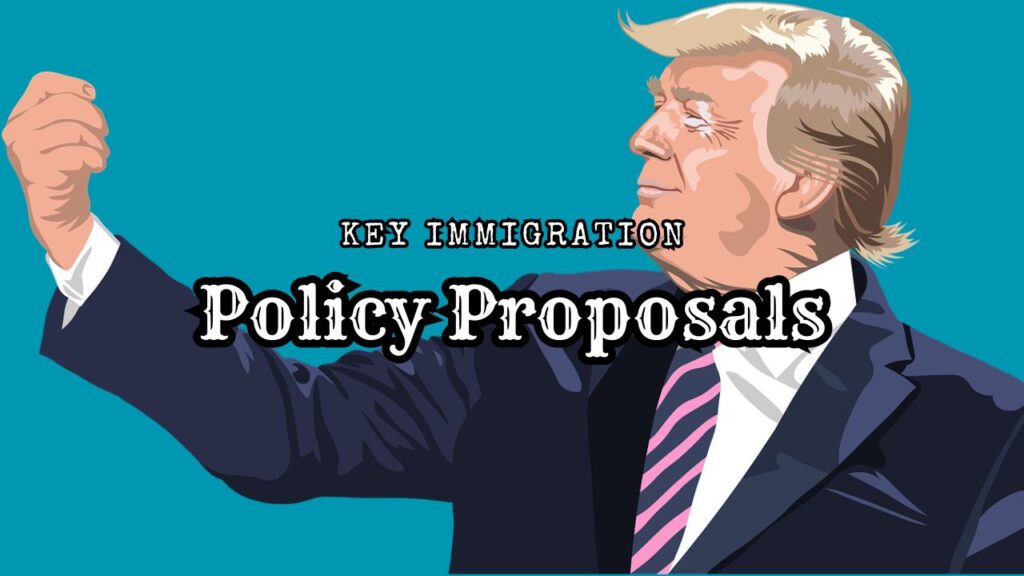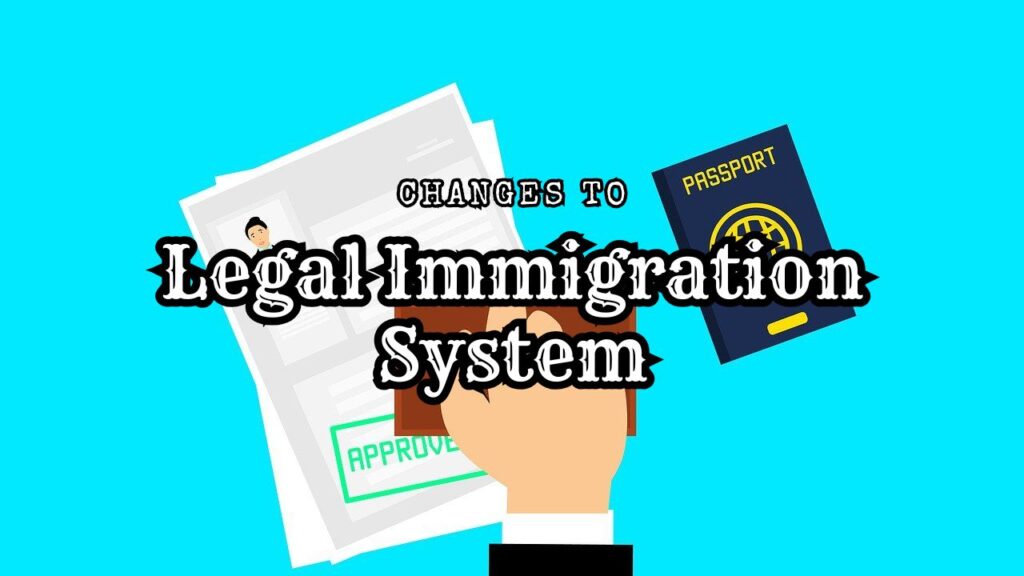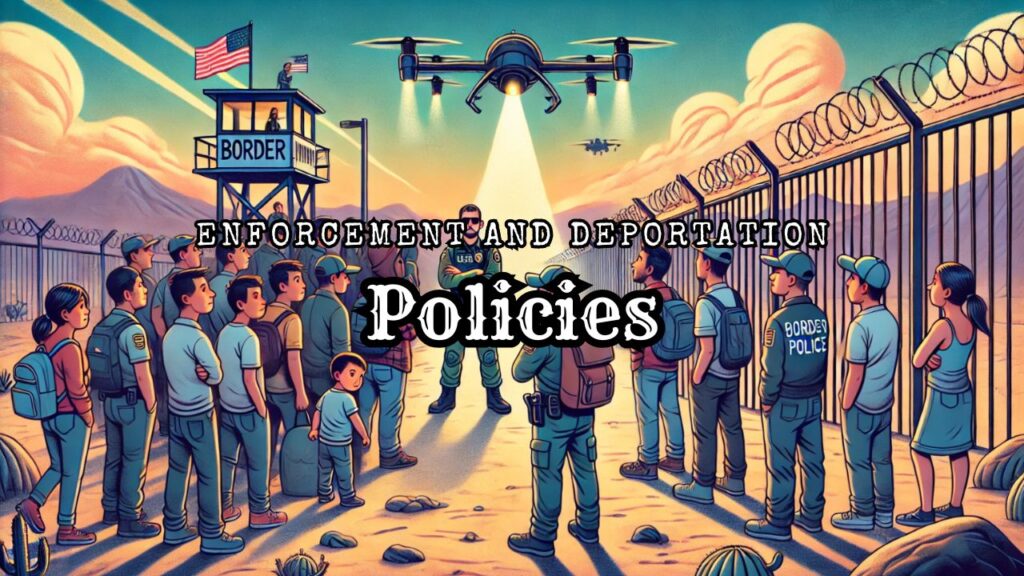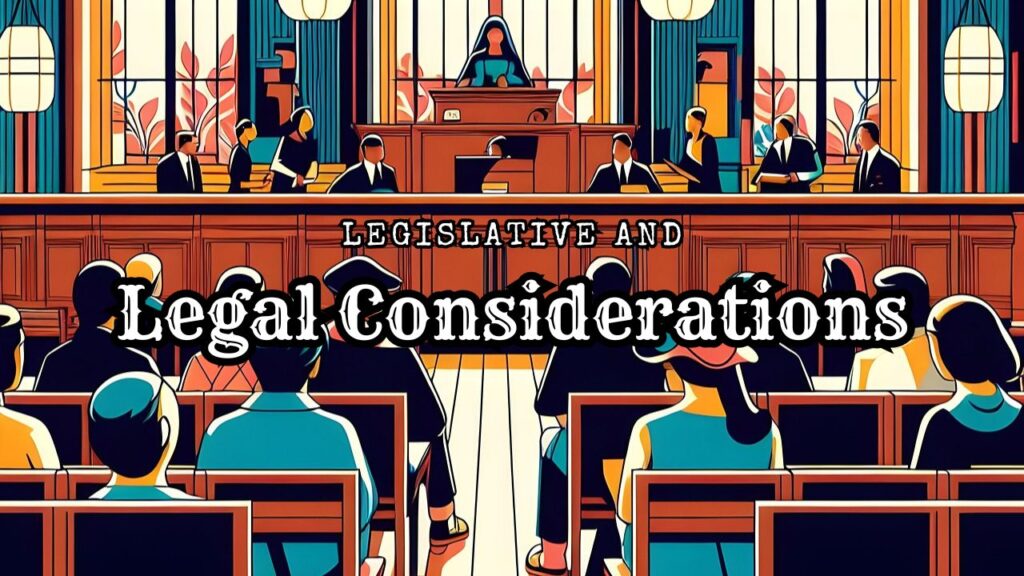Have you noticed how immigration has become the defining issue of our time? As you try to make sense of the complex debate about Trump immigration policy changes, here’s something that might surprise you – nearly half of your fellow Americans now rank immigration among their top concerns. It’s a number that reveals just how deeply this issue affects your community and country.
You’ve likely been following how Donald Trump’s approach to immigration continues to be one of the most transformative and debated aspects of American politics. Whether you’ve watched the news coverage or discussed it with friends and family, you’ve seen how his proposals are reshaping the national conversation.
What you might find particularly interesting about the Trump immigration platform is how it both builds upon and differs from his previous positions. You’re witnessing a significant shift in the landscape since his first term, and you’ll notice his proposals have evolved to address new challenges at the border and within the legal immigration system.
If you’re trying to understand these changes, you’re not alone. Whether you’re a business owner concerned about workforce implications, a border state resident, or simply someone trying to make sense of the immigration debate, these policies could directly impact your community and your future.
As you read through this comprehensive analysis, you’ll discover the details of Trump’s current immigration proposals, understand their potential impacts, and learn what they could mean for America’s immigration system. You’ll gain insights from policy experts, understand the complex legal considerations, and see how these changes might affect your community.
You might find immigration policy overwhelming – and that’s perfectly normal. But don’t worry! You’ll find everything broken down in clear, straightforward terms. Ready to explore what the Trump immigration platform really means for 2025 and beyond?
Key Immigration Policy Proposals

You know that moment when you’re trying to piece together all the details of a complex policy proposal? Let me help you break down Trump immigration key plans for 2025 in a way that’ll make sense. Let’s dive into what you really need to understand about these proposals.
First, let’s talk about what you’ve probably heard most about – the border wall. While you might remember the wall discussions from previous years, the 2025 proposal has some interesting new twists. You’re looking at a plan that calls for an additional 300 miles of physical barriers, but here’s what you might not know – the proposal now includes advanced technology you’d expect to see in a sci-fi movie. Think AI-powered surveillance drones and thermal imaging systems that you can spot from miles away.
Here’s something that might surprise you about the funding approach – you’re seeing a shift from the previous “Mexico will pay” stance. The new proposal you’re hearing about includes a combination of congressional appropriations and what they’re calling “remittance fees” – essentially, you’d see new charges on money transfers to certain countries, which they estimate could generate $4 billion annually.
When it comes to Border Patrol, you’ll want to pay attention to the numbers. The proposal you’re looking at calls for hiring 5,000 new agents and providing them with what they’re calling “next-generation” equipment. You’d see these agents equipped with better technology, but here’s the catch – you’re also looking at a complete overhaul of their training programs.
Let’s talk about something you might not have heard much about in the news – the international agreements. You’d be seeing what they’re calling “Safe Third Country Plus” agreements. What does this mean for you? Essentially, you’d see your country working with not just Mexico, but also Guatemala, Honduras, and El Salvador in new ways. These agreements would affect how you see asylum claims processed.
Now, here’s what you really need to understand about the emergency powers piece – you’re looking at proposals that would let you see some pretty significant changes. The plan suggests using national emergency declarations that would allow you to witness faster deportation processes and what they’re calling “expedited removal procedures” across the entire country, not just at the border like you’ve seen before.
You might be wondering about the practical timeline for all this. Here’s what you should know – while some of these changes you’d see pretty quickly through executive actions, others would require you to wait for congressional approval. The proposal suggests you’d see the first phase of implementation within 100 days, but you’re looking at a 2-3 year timeline for full deployment of all proposed measures.
Want to know more about how these policies might affect legal immigration specifically? That’s what we’ll cover in the next section, and you’ll want to pay close attention because it could impact everything from how you hire workers to how your family members immigrate to the US.
Changes to Legal Immigration System

You’re about to see some major proposed shake-ups to how legal immigration works in America. If you’ve ever dealt with the immigration system – whether as an employer, family member, or immigrant – you know it can be more complicated than assembling furniture without instructions. Let’s break down what’s on the table for 2025.
Let’s start with something that might affect your business – the H-1B visa changes. You’re looking at what they’re calling a “wage-prioritized” system. Instead of the lottery you’re used to, you’d see visas awarded to companies offering the highest salaries first. If you’re a tech company or startup, you’ll want to pay attention here – the minimum salary requirements you’d need to meet would jump significantly, potentially to $150,000 annually per H-1B worker.
Here’s something that might affect your family – the proposed changes to family reunification. You know how right now you can sponsor your parents, adult siblings, and adult children? Under the new proposal, you’d only be able to sponsor your spouse and minor children. They’re calling it “nuclear family immigration,” and you’d see it reduce family-based green cards by about 40%.
The merit-based system they’re proposing would feel familiar if you’ve ever played a video game with experience points. You’d earn points based on things like:
- Your education level (you’d get more points for advanced degrees)
- Your English proficiency (you’d need to pass a stricter language test)
- Your salary offers (higher pay means more points)
- Your age (you’d score higher if you’re between 25-45)
- Your existing job offers in high-demand fields
Speaking of asylum – you’d see some significant changes there too. Instead of what you’re used to, where people can request asylum at the border, you’d see a new system requiring asylum applications at U.S. embassies abroad first. You’re looking at stricter criteria for what qualifies as a valid asylum claim, and you’d need to provide more documentation upfront.
Here’s something that might surprise you about the refugee program – you’d see annual caps set at historically low levels, around 15,000 per year. But there’s a twist you might not expect – the proposal includes special provisions for religious minorities and those who assisted U.S. military operations.
Want to know about processing times? You might like this part – they’re proposing what they call “extreme vetting,” but also promising faster processing. You’d see more rigorous background checks, but they claim you’ll get decisions faster thanks to increased automation and staffing.
Think about it like getting a security clearance – you’d provide more information upfront, but you’d (theoretically) wait less time for a final answer. Though between you and me, I’ve seen enough immigration promises to know that faster processing times can be like those “5-minute” recipes that actually take an hour.
Enforcement and Deportation Policies

You’re probably wondering what these new enforcement policies would mean for your community. Let’s dive into what you’d actually see on the ground if these proposals take effect in 2025.
First, let’s talk about what you’d notice in your everyday life. You know how right now immigration enforcement mainly focuses on the border? Well, you’d start seeing a much bigger ICE presence in cities across the country. They’re proposing to triple the number of interior enforcement officers you’d encounter, with new offices opening up even in smaller cities. If you’re an employer, you’d see more workplace raids and audits than you’ve ever experienced before.
Here’s something that would directly affect your workplace – mandatory E-Verify everywhere. You know how some states already require it? You’d see this expand nationwide. Every employer – yes, even if you’re just hiring a nanny or landscaper – would need to run new hires through the system. They’re claiming you’d have access to an improved version with “near-instant” results, but you’d face steep fines if you don’t comply.
Speaking of your local community, you’d see major changes if you live in a sanctuary city. The proposal would hit your city where it hurts – the wallet. You’d see your community lose federal funding for everything from law enforcement to transportation if your local officials don’t cooperate with ICE. Your local police would be required to share information about immigration status with federal authorities.
Here’s something that might affect your neighborhood – they’re proposing what they call “visa overstay enforcement teams.” You’d see these units specifically targeting people who’ve stayed past their visa expiration dates. They estimate you’ve got about 5.7 million visa overstays in the country right now, and you’d see a massive push to locate and deport them.
Let’s talk about the deportation process itself. You know how currently you might see someone get multiple hearings and appeals? The new system you’d encounter would fast-track removals. If you’re found to be in the country illegally and can’t prove you’ve been here for more than two years, you’d face what they call “expedited removal” – meaning you could be deported within days, not months or years.
Want to know about workplace enforcement? You’d see something they’re calling “corporate responsibility measures.” If you’re running a business, you’d face criminal charges – not just civil penalties – for knowingly hiring unauthorized workers. They’re talking about minimum mandatory fines that would start at $25,000 per violation.
Economic and Social Impact Analysis

You might be wondering how all these immigration changes would hit your wallet and your community. Let’s break down what you’d actually see in your daily life if these policies take effect.
Here’s something that might surprise you about the costs – you’re looking at an estimated $400 billion price tag over five years for full implementation. You’d see this money coming from your tax dollars, with about 45% going to enforcement and 30% to new technology. But here’s the thing – they’re claiming you’d see long-term savings from reduced public service costs, though economists you’d trust have debated these numbers.
Let’s talk about what you’d notice at the grocery store. Remember when farm labor shortages sent produce prices soaring? You’d likely see similar effects. Agricultural groups estimate you’d be paying about 25-30% more for fresh fruits and vegetables, or an overall 10% increase in food prices. If you’re grabbing strawberries or lettuce, you might feel the pinch within months of these policies taking effect.
Here’s how it might affect your job market. If you’re in construction, hospitality, or agriculture, you’d see significant workforce changes. Some states estimate they’d lose up to 20% of their construction workforce. But here’s the flip side – you might see wages increase in these sectors as employers compete for fewer workers. Studies suggest you’d see an 8-12% wage increase in traditionally immigrant-heavy industries.
What about your local community? You’d notice changes in your neighborhood schools pretty quickly. If you’re in a district with high immigrant populations, you might see your school losing funding due to decreased enrollment. Some districts estimate they’d lose up to 15% of their student population, which means you’d see budget cuts affecting all students.
Here’s something affecting your healthcare costs – many rural hospitals where you live depend on immigrant healthcare workers. With stricter visa policies, you’d see longer wait times and potentially higher costs as these facilities struggle to staff adequately. Some estimates suggest you’d see up to 20% of rural medical facilities facing severe staffing shortages.
Want to know about housing in your area? Real estate analysts predict you’d see some interesting shifts. In cities where you’ve got large immigrant populations, you might see rental prices drop initially due to decreased demand. But if you’re in construction-heavy areas, you could see new housing costs rise due to labor shortages.
Legislative and Legal Considerations

Think of it like a giant puzzle where you need all the pieces to fit perfectly. You’re looking at proposals that would require different levels of approval – some that you’d see happen through executive action alone, while others would need Congress to play ball.
Here’s what you might not realize about the executive orders being proposed. While you’d see some immediate changes to enforcement priorities and border procedures, there’s a catch – you’re bound by something called the Anti-Deficiency Act. This means you can’t spend money that Congress hasn’t approved, even under executive orders. So those plans for new border technology you’re hearing about? You’d need congressional funding for those.
Let’s talk about what you’d see in the courts. You know how previous immigration policies faced legal challenges? Well, you’d likely see similar battles, especially in states like California and New York. Legal experts predict you’d face immediate challenges on several fronts:
- Your constitutional rights regarding due process
- Your state’s rights to determine local law enforcement policies
- Your rights under international refugee treaties
- Your property rights for border wall construction
Here’s something interesting about state versus federal powers that might affect you. While you’d see the federal government claiming complete authority over immigration, your state might have different ideas. If you’re in a state with sanctuary policies, you’d probably see lengthy court battles over federal funding cuts and enforcement cooperation.
Speaking of existing laws, you need to understand how these proposals interact with laws you already have on the books. Remember the Immigration and Nationality Act? Any changes you’d see would need to work within this framework unless Congress amends it. That’s like trying to renovate your house while following both old and new building codes.
Want to know what this means for your state specifically? You’d see a complex web of federal mandates trying to override state laws. If you’re in a border state, you’d face additional complications regarding property rights and law enforcement jurisdiction.
Here’s something that might catch you off guard – the international treaty obligations affecting these policies. You’re bound by various international agreements, and some of these proposals would require you to either renegotiate or potentially withdraw from certain treaties.
Recapping Trump Immigration Policy 2.0
When you look at 2025 Trump immigration proposals, you’re seeing some of the most sweeping changes to American immigration policy in decades. From what you’d experience at your workplace to what you’d notice in your community, these policies would touch virtually every aspect of American life.
Remember those numbers we discussed? You’re looking at potential changes that would affect millions of people – from the workers at your local restaurant to the doctors at your hospital. While you’d see some immediate effects like enhanced enforcement and workplace verification, other changes would take years to fully impact your community.
Here’s what you really need to keep in mind as you process all this information:
- You’d see significant economic ripple effects in your daily life
- Your local community would likely experience substantial changes
- You’d need to prepare for new workplace requirements
- Your state might handle these changes differently than others
- You’d want to stay informed about legal challenges and implementation timelines
What should you do with all this information? If you’re an employer, you might want to start preparing for stricter verification requirements. If you’re in an immigrant-heavy industry, you’d be wise to start planning for potential workforce changes. And if you’re just a concerned citizen, you’ll want to keep following these developments as they unfold.
Remember, though – what you’re looking at are proposals. Like any major policy changes, you’d see modifications and compromises along the way. The final version that affects your life might look quite different from what’s being proposed today.
Want to stay informed? You might want to follow local news sources for updates on how these policies would specifically impact your community. After all, understanding these changes isn’t just about national policy – it’s about how they’ll affect you, your family, and your neighborhood. Need advice on any particular case? Then of course, the attorneys at the American Visa Law Group are ready to advise. Just contact us at 510-500-1155 or email us at info@usavisalaw.com. Now is not the time to delay in getting your immigration situation in order!
